GUEST BLOG: Navigating modern warfare: PNT beyond GPS
BlogNovember 21, 2023

The issue of position, navigation, and timing (PNT) plays a pivotal role in the effectiveness and precision of modern weapons systems, making PNT indispensable in contemporary warfare.
In an era where military operations are increasingly reliant on technology, accurate geospatial data is paramount. PNT systems provide real-time information about the location of assets, enabling precise targeting, navigation, and coordination of forces on the battlefield. Without reliable PNT, the efficiency of weapon systems – including drones, guided missiles, and autonomous vehicles – is compromised, resulting in decreased accuracy and operational capability. In an environment where split-second decisions and rapid response are essential, PNT serves as the foundation for strategic advantage and mission success in modern warfare.
As a result of PNT’s critical role, aerospace and defense thought leaders spend considerable time and energy ensuring a global navigation satellite system (GNSS) like GPS is available as often as possible – while preparing for potential situations when is not. There are some emerging innovations that foster the reliable sharing of PNT data across a battlespace.
Several traditional solutions offer GPS alternatives for PNT: (Figure 1.)
- Atomic clock: Rubidium oscillators, cesium, and hydrogen maser techniques are used to source non-GPS PNT at network nodes where these clocks reside.
- Celestial navigation: A centuries-old technique, also known as astronavigation, position information is derived from timed angular measurements of stars and other celestial bodies.
- Terrestrial image analysis: Uses knowledge of landmarks and terrain when weather allows.
- Inertial sensors: Tracks and calculates relative movements from a known position.
- Magnetic navigation: Map-based navigation system that uses magnetic-anomaly fields maps as navigation signals.

[Figure 1 ǀ Alternatives to GPS for position, navigation, and timing (PNT). Source: GAO/DoD.]
These solutions represent promising methods of PNT sourcing, but to become practical alternatives to GPS in modern military threat environments, they must reliably preserve and distribute PNT across all domains, especially when countered with significant electromagnetic interference, such as an adversarial electronic attack.
Two emerging innovations are currently capable of this crucial functionality, with the first being directional ad hoc MILCOM [military communications] networking. Solutions that leverage spatial degrees of freedom are more resilient than traditional omnidirectional solutions. Software-defined antennas like the new Halo digital beamformed antenna, enable an ad hoc network powered by numerous simultaneous data links that simultaneously sense in all directions. These form autonomous links that create a mesh, which facilitates the sharing of PNT sourced from GPS alternatives.
The other innovation is resilient edge node solutions: Future edge node solutions are most effective when they can seamlessly switch between their most capable GPS state to an equally reliable mode when GPS is not present. Cubic has a personnel locator system (PLS) that delivers this capability, with a modern combat search and rescue edge node solution that U.S. and NATO forces use to locate downed pilots. It was deployed in the Launch America effort when Space-X and NASA returned Americans to space in 2020. While PLS uses GPS when it is available, it remains operational in challenged scenarios by using direction-finding and/or ranging techniques.
Alternate PNT innovations are not only promising but absolutely necessary for modern warfare, as they reliably and securely share PNT information across all domains during a conflict. New PNT networking solutions demonstrate that a path to GNSS independence is not only necessary but accessible.
Scott Rosebush is VP and GM, Secure Communications, Cubic Defense and Jason Wilden is a Technical Fellow, Secure Communications, Cubic Defense.
Cubic Defense www.cubic.com/defense








